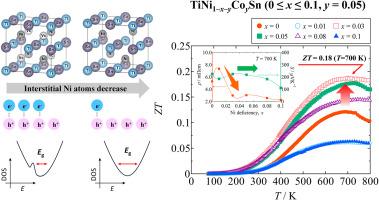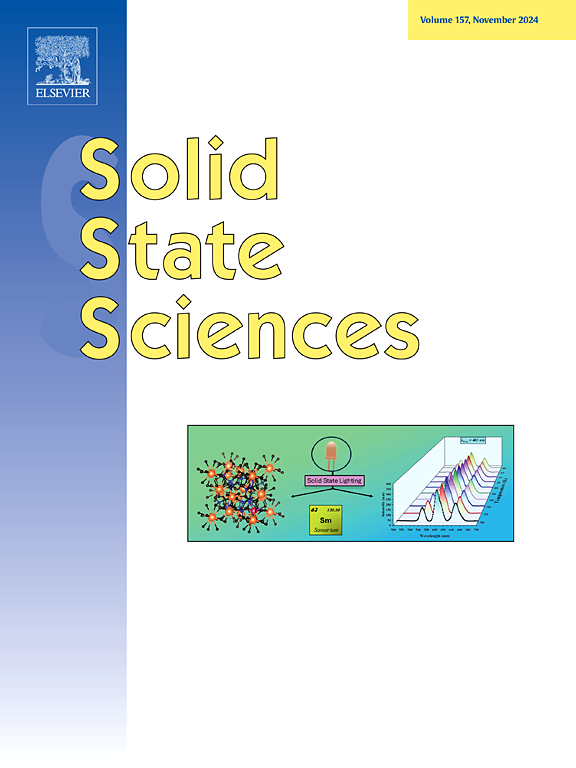ti - 1 - x - ycoysn半heusler合金的p型热电性能
IF 3.3
3区 化学
Q2 CHEMISTRY, INORGANIC & NUCLEAR
引用次数: 0
摘要
TiNiSn是一种低毒的n型热电材料。通过在Ni位上取代Co原子,TiNiSn的电导率可由n型调整为p型。然而,ZT值低于n型TiNiSn,主要是由于其更高的电阻率。为了降低电阻率,必须增加载流子密度或迁移率;塞贝克系数绝对值减小,与电阻率呈权衡关系。为了解决这一问题,我们通过电弧熔化和热处理工艺制备了p型热电材料TiNi1-x-yCoySn(0≤x≤0.1,0.01≤y≤0.05)。因此,我们成功地提高了电导率,同时保持了塞贝克系数。空穴载流子密度随间隙Ni原子数的减少而增加,在300 K时电阻率从2.78 × 10−2 Ωcm (x = 0, y = 0.05)降低到6.02 × 10−3 Ωcm (x = 0.03, y = 0.05),降低了78%。与TiNi0.95Co0.05Sn相比,TiNi0.92Co0.05Sn的ZT值增加了1.5倍(700 K时ZTmax = 0.18),表明减少间隙Ni原子对改善p型半heusler合金TiNiSn的热电性能是有效的。0.18的峰值ZT仍然低于实际实施所需的水平;然而,这可以通过降低晶格导热系数来进一步改善。本文章由计算机程序翻译,如有差异,请以英文原文为准。

P-type thermoelectric properties of TiNi1–x–yCoySn half-Heusler alloy with reduced interstitial Ni atoms
TiNiSn is an N-type thermoelectric material with low toxicity. The electrical conduction of TiNiSn can be tuned from N-type to P-type by substituting Co atoms at Ni sites. However, the ZT value is lower than that of the N-type TiNiSn, primarily due to its higher electrical resistivity. To decrease the electrical resistivity, it is necessary to increase the carrier density or mobility; however, the absolute value of the Seebeck coefficient decreases, which has a trade-off relationship with the electrical resistivity. To solve this problem, we prepared P-type thermoelectric materials TiNi1–x–yCoySn (0 ≤ x ≤ 0.1, 0.01 ≤ y ≤ 0.05) with reduced interstitial Ni atoms by arc melting and heat treatment process. As a result, we successfully improved the electrical conductivity while maintaining the Seebeck coefficient. The hole carrier density increases as the number of interstitial Ni atoms decreases, and the electrical resistivity decreases by 78 % from 2.78 × 10−2 Ωcm (for x = 0, y = 0.05) to 6.02 × 10−3 Ωcm (for x = 0.03, y = 0.05) at 300 K. The ZT value increases by a factor of 1.5 (ZTmax = 0.18 at 700 K) for TiNi0.92Co0.05Sn compared to TiNi0.95Co0.05Sn, indicating that the reduction of interstitial Ni atoms is effective in improving the thermoelectric properties of the P-type half-Heusler alloy TiNiSn. The peak ZT of 0.18 remains below the level required for practical implementation; however, this can be further improved by decreasing the lattice thermal conductivity.
求助全文
通过发布文献求助,成功后即可免费获取论文全文。
去求助
来源期刊

Solid State Sciences
化学-无机化学与核化学
CiteScore
6.60
自引率
2.90%
发文量
214
审稿时长
27 days
期刊介绍:
Solid State Sciences is the journal for researchers from the broad solid state chemistry and physics community. It publishes key articles on all aspects of solid state synthesis, structure-property relationships, theory and functionalities, in relation with experiments.
Key topics for stand-alone papers and special issues:
-Novel ways of synthesis, inorganic functional materials, including porous and glassy materials, hybrid organic-inorganic compounds and nanomaterials
-Physical properties, emphasizing but not limited to the electrical, magnetical and optical features
-Materials related to information technology and energy and environmental sciences.
The journal publishes feature articles from experts in the field upon invitation.
Solid State Sciences - your gateway to energy-related materials.
 求助内容:
求助内容: 应助结果提醒方式:
应助结果提醒方式:


